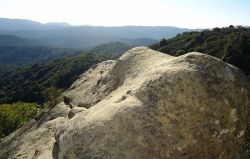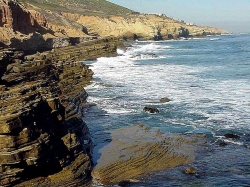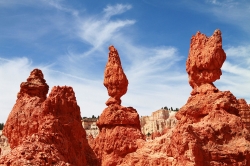Have you ever tried to rip apart a rock? Unless you are the Hulk, you probably cannot even put a crack in one. In fact, unless you are using special tools, you cannot break apart most of the rocks that you find. After all, rocks, are pretty strong. That's why they are used for making buildings and streets. However, you have probably seen rocks or cement that have cracks in them. Maybe the sidewalk by your house has cracks in it, with plants growing in the gaps. Have you ever wondered why it looks like these plants can make cracks in the sidewalk when you cannot?

I think it's going to take more than a shovel to break this down and move it.
Tomwsulcer, CC0, via Wikimedia Commons
Scientists, who have words for everything, also have a name for breaking rocks. They call it
weathering when rock is broken down into smaller and smaller pieces. This can happen in a few ways. One way is when things push or pull on rocks. The roots of a tree, growing over many years, can slowly break apart dirt and rock to hold itself down and grow its roots deep into the ground. Another kind of weathering happens when rock is broken down by chemicals. This can happen when water hits some kinds of rock and turns into a weak acid. Acid is the same stuff that helps your body break down the food you eat. This is a good reason why you should not crawl around in wet caves.
After rocks are broken apart during weathering, something else happens.
Erosion is when broken rocks or dirt are moved from one place to another. This happens when things like water, wind, and gravity work together to move the bits of broken down rocks.
Water is a liquid found all over the Earth that causes most of the weathering and erosion we see when it flows against rocks or freezes into ice. Water might not seem strong, but it is the thing that most often breaks a rock! Remember, water can come in many different forms. Water in the ocean crashes onto the beach shore in the form of powerful waves. Over time, these waves can break apart the rocks in cliffs by the beach and change their shape.

Not a good beach for your boogie board.
Water also can break and move rocks when it runs over rocks for a very long time. When water breaks down rocks like this, it can make the rocks very smooth, like rocks that have been in creeks for a very long time. Picture how a chunk of butter slowly melts on hot bread. Over time, the sides of the butter get worn down and smooth. Of course, rocks are a lot harder than butter, but remember that the water in a creek is running over those rocks for a lot, lot longer than it takes to melt butter!
Another way to break or move rock is with the wind. When different parts of the Earth are different temperatures, the air starts moving and creates
wind. How does this happen? I am not sure if you have seen this before, but water reflects sunlight so much that it can even hurt your eyes. Dirt and rock are different. Most of the light that hits them gets taken in and warms them up. During the day, the air over the land gets hotter from all this heat and the air over the water stays cooler. The heat from the land makes the air rise and that sucks in colder air from over the water. When the colder air over the water moves in to take the spot of where the warmer land air once was, that creates wind.
Wind erosion happens when wind picks up sand and blows against big rock cliffs. Even though it does not happen right away, the sand in the wind slowly breaks down the rocks. It's like the way sand paper is used to smooth out wood. Even though it takes some time, the sand in the wind makes the rocks break apart and smooth out. Water waves, wind, and gravity all work together to cause the erosion that shapes the sand dunes you see at the beach.

Meet you at the top of the middle one. You go first.
Lisafern, CC0, via Wikimedia Commons
So let's review what we just learned. Rocks get broken during weathering, and then rocks get moved during erosion. Both water and wind are used to help with weathering and erosion. In a way, water and wind are kind of like shovels. Like shovels, water and wind work to break up rock and to move it to new places. However, unlike shovels, water and wind do not need anyone to help them break up rocks. Instead, water and wind can break up and move rocks all on their own.